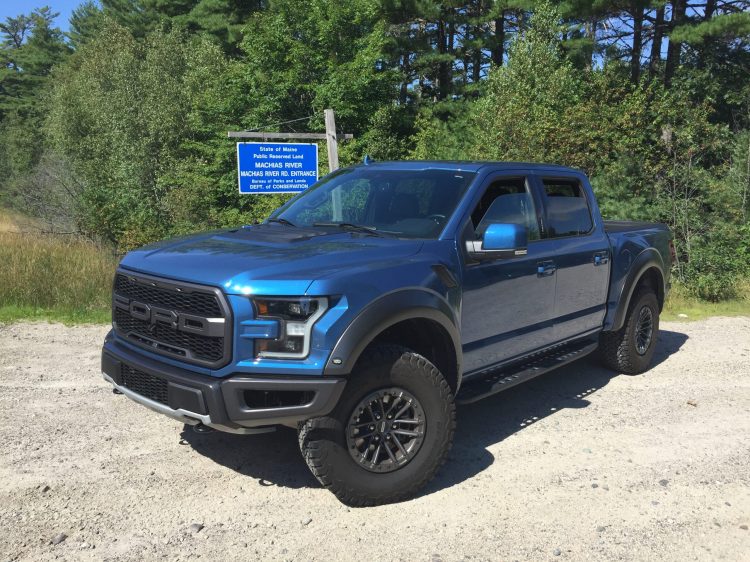For Ford’s domestic rivals, the Raptor version of the top-selling F-series pickup line has presented huge marketing issues to overcome.
With outsized pricing—as well as matching profits—the Raptor has a distinct dynamic, an extroverted character that overshadows any potential competitor. Indeed, over six years in, no other automaker has yet to build a pickup truck anywhere close to the Raptor.
Originally created in the spirit of the famous off-road pre-runners that populate the west, the initial Raptor was designed by people at Ford who love performance—in the dirt, and on the street. To make their Frankenstein truck, and it can be a beast, stand out, they gifted it with an extraordinarily capable long travel suspension that lets the truck bound over hurdles off road—flying when necessary, or prodded—plus a potent engine to make the almost 3-ton machine achieve the desired acceleration in every environment.
The engine bay used to be filled with a 6.2-liter V-8. For the last four years, Ford has employed its 3.5-liter Ecoboost twin-turbo high-output V-6 engine which pumps out 450-hp here while earning EPA ratings of 15/18-mpg—a giant step up from the original V-8. Realized economy with the warmer days of summer clocked in at a commendable 17.3-mpg, including a short stint at over 20-mpg.
The Ford rumor mill has the supercharged V-8 from the upcoming GT500 making an appearance on the Raptor’s options list in a few years, however, Ford won’t confirm whether or not the eager Raptor needs a 700-hp engine.
Bestowed with ample hardware, two things did make my Raptor wish list for improvement. First, the chassis’ impressive off-road performance, plus the ability to completely obliterate big road imperfections, is off-set by the inability to absorb broken pavement and everyday potholes—of which our roads supply a steady diet of. The long-travel Fox shocks, with remote reservoirs, do an admirable job, but I couldn’t help but think that a rugged independent rear suspension would dramatically improve on-road ride dynamics on less than perfect surfaces.
The only other complaint is really a suggestion. While Ford packs the Raptor with a robust tow rating, plus BLIS-blind spot monitoring for the truck and any trailers, as well as a reverse system for truck and trailer, the rear camera is mounted smack in the middle of the tailgate, where is can become useless when your cargo necessitates lowering the tailgate. This also creates havoc for the rear parking sensors. A camera, or cameras, mounted in the taillight bezel would rectify both maladies.
The rest of the Raptor is sensory overkill, steroids for your truck fetishes. Just the list of visuals, which Ford researched and installed accordingly, creates consumer interest. This pickup gets noticed, a lot. Six inches wider than a ‘regular’ F-150, the Raptor packs huge fender flares and moldings onto the side, with oversize 17-inch tire and wheel packages to handle any terrain. There is the unique Raptor front grille, the Raptor specific marker lamps all over the truck, the decidedly larger bumpers, the tow hooks, the visible skid plates, the blacked out hood louvers, plus the massive dual exhausts and the industry’s best running boards, all grabbing retina attention. You don’t so much as notice the Raptor, as it inserts itself into your field of vision—especially in Ford Performance Blue Paint.
Inside, the tempo may slow down a little on the visuals, but it’s hard to ignore the blue-stitching on the excellent Recaro suede and leather sport seats (heated and cooled, with memory for the driver), the overhead panel of accessory switches, and the upgraded Sync 3 system complimented by FordPass Connect 4G Wi-Fi.
Most Raptor buyers opt for the larger SuperCrew model over the Supercab, because of the extra passenger space and the wide, flat floor. Quiet on the pavement, despite those big tires, the Raptor is civilized for any chore short of jumping range fences and off-road moguls.
Pricing starts at $55,840. As shown, our sampled Raptor tipped the scales at $75-large with the addition of the 802A option package, as well as an array of other goodies like twin-panel power sunroof, Raptor technology including dynamic cruise, 360-degree camera, and side-mirror spotlights (very clever). Add Bang & Olufsen audio, auto climate, remote start, heated steering wheel, and, well, you get the idea….this can be a very serious work truck or an impressively comfortable cruiser.
Other notables; the 36-gallon fuel tank can render almost 650-miles of driving range, the power tailgate is easy to use, and there is no mistaking the presence of this pickup.
Ford has sold over 2,400 F-series trucks every day so far this year. The Raptor may be a small niche among those sales numbers, yet the halo effect for the brand is immeasurable.
Comments are not available on this story.
Send questions/comments to the editors.




